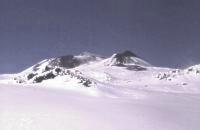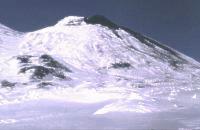

Updates December 1998
14 December 1998
It took SE Crater more than 14 days to arrive at its fourteenth eruptive
episode in three months, last night (13-14 December), confirming the trend of
ever increasing quiet intervals between eruptive episodes. As usually before
the paroxysmal phase of the episode, Strombolian activity began some 24 hours
or so earlier. Carmelo Monaco of IGGCT was at Montagnola for skiing during the
day, and heard explosion sounds from the direction of SE Crater, but clouds
over the summit prevented visual observations. However, at about 1930 h (local
time=GMT+1) the summit became visible from Catania, and by this time Strombolian
bursts from SE Crater occurred every few seconds. Between 2000 and 2030 a growing
incandescent spot became visible below the fountain, this was a slowly-moving
lava flow at the "spillover" at the southern crater rim. During the next two
hours, lava spilled down the southern (and possibly also the southwestern) flank
of the cone, and pyroclastic ejections became gradually stronger. The culminating
phase began at about 0430 h this morning, and it was marked by strong seismic
activity (information from G. Patanè, IGGCT and Osservatorio Sismologico di Acireale). The
exact duration of this phase is not yet known but it probably was similar to
those of previous eruptive episodes, that is, between one and two hours. Tephra
was carried by a northerly wind towards south, leaving a dark streak on the
snow fallen during the days before.
This morning, clear weather is permitting perfect views of the volcano from
Catania. The cone of SE Crater is covered almost all over with new pyroclastics
and appears to have grown somewhat, although it is still lower than the rim
of the former central crater (at 3300 m elevation). The extent of new lava flows
cannot be ascertained, but it is probably similar to that of earlier flows.
Activity has returned to low levels, possibly there is still minor Strombolian
activity that may continue for another few days before complete quiet returns.
The previous eruptive episode, on 29 November, was not observed visually due
to bad weather, but its effects were studied four days later, during a visit
to the crater on the afternoon of 3 December by Boris Behncke and two geologists
from the United States. That visit was made while much fresh snow covered the
summit region, and it was only possible to reach the rim of SE Crater while
the other summit craters could not be visited.
Lava flows of the 29 November eruptive episodes may have been less voluminous
than earlier flows, but we did not see if lava had flowed down the northern
sector of the cone; however, the crater rims on that side did not appear to
have another "spillover" point like that on the southern side. Lava had spilled
through the breach in the southern crater rim and reached down to the base of
the cone. Fresh snow covered much of the recent lava, and possibly also some
of the 29 November lava. We climbed to the summit of the newly formed cone at
SE Crater and observed the vent that had produced all activity in the past months;
there was no eruptive activity, and only weak gas emissions occurred from time
to time. The summit crater was found to be about 50-80 m wide, its rim being
highest on the southeastern side while there were low points on the western,
southern and northeastern sides. The crater floor was relatively flat and had
a central pit about 15 m wide in its center; this was the vent from which the
most recent activity had originated. While staying on the crater rim it was
possible to see that the summit of SE Crater was only a few tens of meters lower
than the rim of the former summit crater (elevation 3300 m), and thus SE Crater
has grown at least 60-80 m since mid-1997.